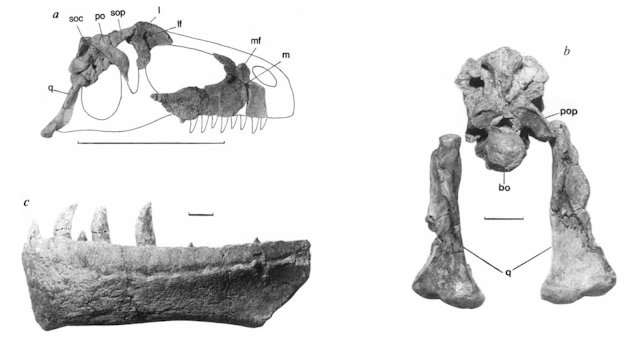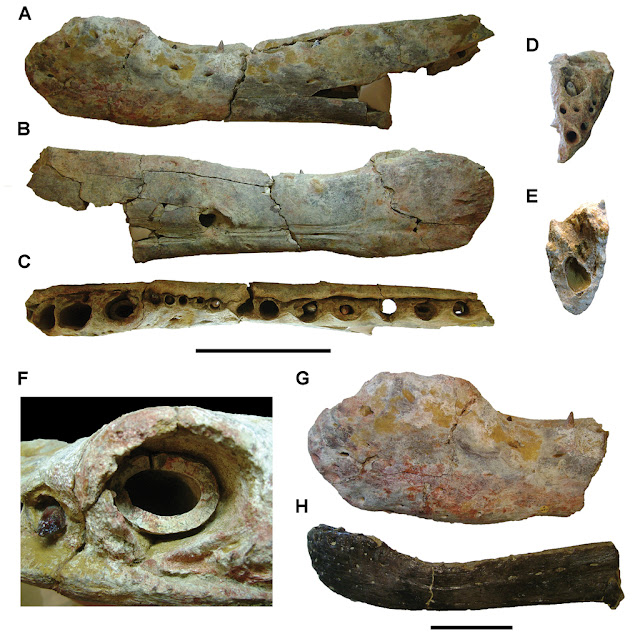Place: South America.
Size: 35-50 feet Feet (10.6-15.3 meters).
Weight: 6.3-8.2+ tons.
Diet: Carnivore.
Skull: 1.498-157.8+ cm.
Type species: G. carolinii.
My Additional Species:
1. G. (Mapusaurus) roseae.
2. G. (Tyrannotitan) chubutensis.
According to Kenneth Carpenter (2002), in most predatory theropods used their mouths first to grab prey first, and then they would grab their prey "in a 'bear hug'" with their hands (pg. 72, "Conclusion"). For Allosaurus, a relative of Giganotosaurus, its arms were relatively long and robust. The range of motion in its arms seems to have allowed it to grab and pull "moderately large prey" towards it. Carpenter says that evidence of Allosaurus using its arms to hunt large sauropods isn't present ("Biomechanical Analysis," pg. 71). Text-figure 9 shows Allosaurus', and other theropod's, range of motion for their hands (pg. 69). Apparently, it can bend its hand quite well outward. Perhaps this was the same for Giganotosaurus. Matt A. White et al., (2015) says that carcharodontosaurid arms were similar to tyrannosaurs, in which they used their jaws to grab their prey first and used their arms to secure it ("Discussion," p. 6). Therefore, it seems that carcharodontosaurids like Giganotosaurus used their hands to help their jaws capture prey mainly. However, their hands might have been able to bend slightly like Allosaurus'.
Carnivorous theropod dinosaurs had enamel in their teeth, so they must have had lips to cover and protect their teeth (Reisz and Larson, 2016, pg. 64-66) (Blake Eligh, 2016) (Mindy Weisberger, 2016) (Emanuela Grinberg, 2016) (Phys, 2016). Therefore, Giganotosaurus would have had lips covering its teeth. Interestingly, dinosaurs couldn't move its tongues (Mindy Weisberger, 2018) (ScienceDaily, 2018).
1. MUCPv-CH 1 (Skull from Coria and Salgado, 1995, p. 225 Figure 1) (Scale bars are A: 1 meter, B and C: 10 cm):Length: 41 feet (12.4 meters).
2. MUCPv-95 (Dentary from Calvo and Coria, 1998, pg. 120 Figure 5):
Length: 43 feet (13.1 meters).
The holotype specimen of G. carolinii, MUCHv-CH 1, is 70% complete (Jorge Orlando Calvo, 1999, p. 26-27), and measures 41 feet (12.4 meters) (Coria and Salgado, 1995, give a length of 12.5 meters, while Coria and Currie, 2002 give a length of 12.0 meters). The holotype's skull was 1.498 meters long, and its femur was 132.5 cm long. A second specimen, MUCPv-95, is based on a dentary (bottom jaw fragment) that measures 59 cm, compared to MUCPv-CH 1's 56-cm dentary. Based on this, MUCPv-95 was 43 feet long (13.1 meters), 5.4% longer than MUCPv-Ch 1. Its skull would have been 1.578 meters long. This makes Giganotosaurus, in total, 41-43 feet long (12.4-13.1 meters).
All three species have a chin/ventral process or flange on their dentaries (Novas et al., 2005, p. 227) (Coria and Currie, 2006, pp. 83-84). All three species have 15 teeth in its dentary, and 2 serrations per 1 mm on its teeth (Novas et al., 2015, pp. 6-7). Both G. carolinii and G. (Mapusaurus) roseae had one pneumatopore/pneumatic foramen on the medial views of their quadrates (Hendrickx et al., 2015, Figure 5 B and C). G. (Tyrannotitan) chubutensis doesn't seem to have one preserved. All three species have tall dorsal and caudal neural spines (Novas et al., 2015, pp. 13-14, and 17) (Coria and Currie, 2006, pp. 90 and 92) (Coria and Salgado, 1995, p. 225). Coria and Salgado (1995) said that G. carolinii had tall dorsal neural archs (p. 225), but Figure 2 shows what seems to be tall dorsal neural spines as well. All three species also had similarly-shaped ilia (Novas et al., 2005, p. 227 Figure 1) (Coria and Currie, 2006, p. 99 Figure 26). G. carolinii's ilium was damaged (Carrano et al., 2012, p. 235), but it's likely that its ilium was shaped like the other two species'. All three species seem to have similarly-shaped femora, and share a large 4th trochanter (Coria and Salgado, 1995, pp. 225-226) (Coria and Currie, 2006, p. 103) (Novas et al., 2015, p. 22). G. (Tyrannotitan) chubutensis' autapomorphy (distinguishing characteristic) that separates it from G. carolinii and G. (Mapusaurus) roseae is that three of its teeth had bilobate denticles on its teeth (Novas et al., 2015, p. 8).
Coria et al., 2019 on Taurovenator (Discussion para. 4):G. (Mapusaurus) roseae Skull (NBC, 2006):
Giganotosaurus carolinii vs. Andesaurus:
Patagotitan:
MOZ Pv 1221 (Otero et al., 2021, Figure 5) (MOZ Pv 1221 is brown, Andesaurus is yellow, and Limaysaurus is blue):G. (Mapusaurus) roseae hunted the titanosaur Argentinosaurus, the rebbachisaur Cathartesaura, and the ornithopod Anabisetia.
1. Giganotosaurus carolinii:
https://vdocuments.mx/a-new-giant-carnivorous-dinosaur-from-the-cretaceous-of-patagonia.html
Calvo and Coria (1998):
http://www.arca.museus.ul.pt/ArcaSite/obj/gaia/MNHNL-0000776-MG-DOC-web.PDF
Link 2:
https://www.researchgate.net/publication/40662857_New_specimen_of_Giganotosaurus_carolinii_Coria_Salgado_1995_supports_it_as_the_largest_theropod_ever_foundJorge Orlando Calvo (1999) (PP. 17-18, 22-24, 26-27, and 41):
https://www.researchgate.net/publication/284053211_Dinosaurs_and_other_vertebrates_of_the_Lake_Ezequiel_Ramos_Mexia_Area_Neuquen-Patagonia_Argentina
Tu Casu Estu Destino. "Villa el Chocon" (Pg. 1):
http://neuquentur.gob.ar/en/destinations/villa-el-chocon/
Welcome to Argentina. "Carmen Funes Municipal Museum":
https://www.welcomeargentina.com/cutralco-huincul/carmen-funes-municipal-museum.html
https://vdocuments.mx/a-new-giant-carnivorous-dinosaur-from-the-cretaceous-of-patagonia.html
https://www.academia.edu/5642253/Early_uplift_and_orogenic_deformation_in_the_Neuqu%C3%A9n_Basin_Constraints_on_the_Andean_uplift_from_U_Pb_and_Hf_isotopic_data_of_detrital_zircons
Link 2:
https://www.sciencedirect.com/science/article/abs/pii/S0040195110001642
Link 3:
https://www.researchgate.net/publication/248242916_Early_uplift_and_orogenic_deformation_in_the_Neuquen_Basin_Constraints_on_the_Andean_uplift_from_U-Pb_and_Hf_isotopic_data_of_detrital_zircons
International Commission of Stratigraphy Website:
https://stratigraphy.org/news/130
https://psdinosaurs.blogspot.com/2018/12/giganotosaurus-specimen-sizes.html
Link 2:
https://psdinosaurs.blogspot.com/2018/10/how-big-was-mucpv-95.html
Link 3:
https://psdinosaurs.blogspot.com/2018/10/calculations-for-largest-theropods.html
Weight:
Mazzetta et al., (2004) ("Abstract;" Pages 9-10, 12):
http://www.miketaylor.org.uk/tmp/papers/Mazzetta-et-al_04_SA-dino-body-size.pdf
Campione et al., (2014):
https://besjournals.onlinelibrary.wiley.com/doi/full/10.1111/2041-210X.12226
Snively et al., (2018) (Table 3):
https://peerj.com/articles/6432/
Link 2:
https://peerj.com/preprints/27021.pdf
Persons IV et al., (2019) (Table 2):
https://onlinelibrary.wiley.com/doi/epdf/10.1002/ar.24118?tracking_action=preview_click&r3_referer=wol&show_checkout=1
Abstract:
https://onlinelibrary.wiley.com/doi/pdf/10.1002/ar.24118
Hands:
Kenneth Carpenter (2002):
https://www.researchgate.net/publication/225366451_Forelimb_biomechanics_of_nonavian_theropod_dinosaurs_in_predation
Matt A. White et al., (2015) ("Discussion," p. 6):
https://journals.plos.org/plosone/article?id=10.1371/journal.pone.0137709
Lips:
Reisz and Larson (2016) (Pg. 64-66):
https://cansvp.files.wordpress.com/2013/08/csvp-2016-abstract-book-compressed.pdf
Blake Eligh (2016):
https://www.utoronto.ca/news/did-dinosaurs-have-lips-ask-university-toronto-paleontologist
Mindy Weisberger (2016):
https://www.livescience.com/54912-did-t-rex-have-lips.html
Emanuela Grinberg (2016):
https://www.cnn.com/2016/05/22/world/dinosaur-lips-teeth-study/index.html
Phys (2016):
https://phys.org/news/2016-06-dinosaurs-lips.html
Tongue:
Mindy Weisberger (2018):
https://www.scientificamerican.com/article/t-rex-couldnt-stick-out-its-tongue/
ScienceDaily (2018):
https://www.sciencedaily.com/releases/2018/06/180620150129.htm
Speed and Agility:
Blanco and Mazzetta (2001):
https://www.app.pan.pl/archive/published/app46/app46-193.pdf
Snively et al., (2018):
https://peerj.com/preprints/27021.pdf
Dececchi et al., (2020):
https://www.researchgate.net/publication/336117841_The_fast_and_the_frugal_Divergent_locomotory_strategies_drive_limb_lengthening_in_theropod_dinosaurs
EurekAlert (2020):
https://www.eurekalert.org/pub_releases/2020-05/p-trw051320.php
The Canadian Press (2020):
https://www.kamloopsthisweek.com/news/research-says-t-rex-was-built-for-long-distances-not-sprints-1.24134506
Prey:
https://psdinosaurs.blogspot.com/2018/12/size-calculations-for-herbivorous.html
Andesaurus:
Time:
Mannion and Calvo (2010):
https://academic.oup.com/zoolinnean/article/163/1/155/2625609
Calvo and Bonaparte (1991):
https://paleoglot.org/files/Calvo&Bonaparte%201991.pdf
Size:
https://psdinosaurs.blogspot.com/2018/12/size-calculations-for-herbivorous.html
Patagotitan:
Time:
Carballido et al., (2017):
http://rspb.royalsocietypublishing.org/content/284/1860/20171219
Size:
https://psdinosaurs.blogspot.com/2018/12/size-calculations-for-herbivorous.html
MUCPv-251:
https://psdinosaurs.blogspot.com/2020/08/a-giant-sauropod-argentinosaurus-from_22.html
Size:
https://psdinosaurs.blogspot.com/2018/12/size-calculations-for-herbivorous.html
MOZ Pv 1221:
https://psdinosaurs.blogspot.com/2021/01/giant-titanosaurs-40-tons-or-more.html
Size:
https://psdinosaurs.blogspot.com/2018/12/size-calculations-for-herbivorous.html
Enemies:
Ekrixinatosaurus:
Time:
https://www.researchgate.net/publication/262222847_A_new_Abelisauridae_Dinosauria_Theropoda_from_northwest_Patagonia
Size:
https://psdinosaurs.blogspot.com/2018/10/calculations-for-largest-theropods.html
Buitreraptor:
Size:
https://psdinosaurs.blogspot.com/2018/10/calculations-for-largest-theropods.html
Time:
https://www.app.pan.pl/archive/published/app56/app20090127.pdf
Link 2:
https://www.sciencedirect.com/science/article/pii/S0195667117300678
2. G. (Tyrannotitan) chubutensis:
MEF Museum. "Cast Production and Design Services for Museums" Catalog:
https://mef.org.ar/pdf/ExhibitsMEF_2019.pdf
Link 2:
https://mef.org.ar/visits/exhibitions/
Size:
https://psdinosaurs.blogspot.com/2018/10/calculations-for-largest-theropods.html
Time:
Novas et al., (2005) (Pg. 227):
https://www.researchgate.net/publication/7901883_A_large_Cretaceous_theropod_from_Patagonia_Argentina_and_the_evolution_of_carcharodontosaurids
Benson et al., (2010) (Figure 3):
https://www.researchgate.net/figure/Relationships-of-Cretaceous-allosauroids-based-on-the-phylogenetic-analysis-herein_fig3_272152523?_sg=sg8gP3l_KoTmLPM7P9r-Lu_yNk9SC72jXEy7GrKPInaa4D1wqfQQSERNvHNSCGjUX0VdyILWGIKwJYn1Oo3d5w
Full Paper:
https://www.researchgate.net/publication/26892358_A_new_clade_of_archaic_large-bodied_predatory_dinosaurs_Theropoda_Allosauroidea_that_survived_to_the_latest_Mesozoic
Eddy and Clarke, (2011) (Figure 55):
https://www.researchgate.net/figure/Phylograms-and-comparisons-of-body-size-optimization-across_fig27_50892373
Full Paper:
https://www.ncbi.nlm.nih.gov/pmc/articles/PMC3061882/
Novas et al., (2013) (Pg. 11):
https://www.researchgate.net/publication/259045022_Evolution_of_the_carnivorous_dinosaurs_during_the_Cretaceous_The_evidence_from_Patagonia
https://books.google.com/books?id=OsJQDwAAQBAJ&pg=PA104&lpg=PA104&dq=Cerro+Castano+member&source=bl&ots=Z80R-QvpzZ&sig=ACfU3U2EnTHODxW1x5MFakQNnmYpM4Knxg&hl=en&sa=X&ved=2ahUKEwjmyOyu5rfqAhXzj3IEHbF0BEQQ6AEwDHoECAwQAQ#v=onepage&q=Cerro%20Castano%20member&f=false
Ezcurra and Novas (2016) (Pg. 146):
https://www.researchgate.net/publication/305011083_Theropod_dinosaurs_from_Argentina
Tomas et al., (2017) ("Abstract," pg. 2-8):
("Abstract"):
https://www.sciencedirect.com/science/article/abs/pii/S0195667117300836
Utricle Definition:
Palomar College. "Botany 115 Terminology: Fruit Terminology Part 3":
https://www2.palomar.edu/users/warmstrong/termfr3.htm
Merriam Webster. "Utricle":
https://www.merriam-webster.com/dictionary/utricle
http://staff.mef.org.ar/images/investigadores/diego_pol/papers/101.pdf
Link 2 ("Abstract"):
https://www.sciencedirect.com/science/article/abs/pii/S1342937X19302886
International Chronostratigraphic Chart (2019 Version):
http://stratigraphy.org/ICSchart/ChronostratChart2019-05.jpg
Link 2:
http://stratigraphy.org/index.php/ics-chart-timescale
Lips:
Reisz and Larson (2016) (Pg. 64-66):
https://cansvp.files.wordpress.com/2013/08/csvp-2016-abstract-book-compressed.pdf
Blake Eligh (2016):
https://www.utoronto.ca/news/did-dinosaurs-have-lips-ask-university-toronto-paleontologist
Mindy Weisberger (2016):
https://www.livescience.com/54912-did-t-rex-have-lips.html
Emanuela Grinberg (2016):
https://www.cnn.com/2016/05/22/world/dinosaur-lips-teeth-study/index.html
Phys (2016):
https://phys.org/news/2016-06-dinosaurs-lips.html
Tongue:
Mindy Weisberger (2018):
https://www.scientificamerican.com/article/t-rex-couldnt-stick-out-its-tongue/
ScienceDaily (2018):
https://www.sciencedaily.com/releases/2018/06/180620150129.htm
Hands:
Kenneth Carpenter (2002):
https://www.researchgate.net/publication/225366451_Forelimb_biomechanics_of_nonavian_theropod_dinosaurs_in_predation
Matt A. White et al., (2015) ("Discussion," p. 6):
https://journals.plos.org/plosone/article?id=10.1371/journal.pone.0137709
Speed:
Dececchi et al., (2020):
https://www.researchgate.net/publication/336117841_The_fast_and_the_frugal_Divergent_locomotory_strategies_drive_limb_lengthening_in_theropod_dinosaurs
EurekAlert (2020):
https://www.eurekalert.org/pub_releases/2020-05/p-trw051320.php
The Canadian Press (2020):
https://www.kamloopsthisweek.com/news/research-says-t-rex-was-built-for-long-distances-not-sprints-1.24134506
Prey:
Chubutisaurus:
Length:
https://psdinosaurs.blogspot.com/2018/12/size-calculations-for-herbivorous.html
Time:
***Krause et al., (2019) (P. 37, 40, and 42):
http://staff.mef.org.ar/images/investigadores/diego_pol/papers/101.pdf
Bonaparte and Gasparini (1978):https://paleoglot.org/files/Bonaparte&Gasparini_79.pdf
Salgado (1993):
https://www.researchgate.net/publication/290798931_Comments_on_Chubutisaurus_insignis_Del_Corro_Saurischia_Sauropoda
*Weishampel et al., (2004) (Pg. 571):
https://www.researchgate.net/publication/234025996_Dinosaur_Distribution
Mannion and Calvo (2011) (Table 7):
https://academic.oup.com/zoolinnean/article/163/1/155/2625609
*Carrano et al., (2012) (Pg. 257-258):
https://www.researchgate.net/profile/Matthew_Carrano/publication/230808558_The_phylogeny_of_Tetanurae_Dinosauria_Theropoda/links/0912f504a5960e5645000000/The-phylogeny-of-Tetanurae-Dinosauria-Theropoda.pdf?origin=publication_detail
*Fossilworks. "Bayo Overo Member" (105.3-99.7 Ma):
http://fossilworks.org/bridge.pl?action=collectionSearch&formation=Cerro%20Barcino&member=Bayo%20Overo
Ligabuesaurus:
https://psdinosaurs.blogspot.com/2018/12/size-calculations-for-herbivorous.html
Amazonasaurus:
https://psdinosaurs.blogspot.com/2018/12/size-calculations-for-herbivorous.html
Enemies:
Genyodectes:
https://www.researchgate.net/publication/305011083_Theropod_dinosaurs_from_Argentina
Riley Black (2012):
https://www.smithsonianmag.com/science-nature/what-is-genyodectes-144686459/
Irritator:
Time:
https://ui.adsabs.harvard.edu/abs/2019SedG..389..103V/abstract
Rodrigues et al., (2020) ("Abstract"):
Size:
https://psdinosaurs.blogspot.com/2018/10/calculations-for-largest-theropods.html
Angaturama is Likely Irritator:
Aureliano et al., (2018) (Pg. 4, 8, and 12):
Kristen Rogers (2020) ("Competing for food," p. 1):
https://www.cnn.com/2020/04/29/world/spinosaurus-swimmer-discovery-scn/index.html
Santanaraptor:
Time:
https://ui.adsabs.harvard.edu/abs/2019SedG..389..103V/abstract
Rodrigues et al., (2020) ("Abstract"):
A Tyrannosauroid:
Delcourt and Grillo (2018) ("Abstract"):
https://www.researchgate.net/publication/327509211_Tyrannosauroids_from_the_Southern_Hemisphere_Implications_for_biogeography_evolution_and_taxonomy
Supplementary Information:
Original Paper:
Coria and Currie (2006):
https://www.researchgate.net/publication/228655543_A_new_carcharodontosaurid_Dinosauria_Theropoda_from_the_Upper_Cretaceous_of_Argentina
Skeletons:
Nagoya City Science Museum:
http://www.ncsm.city.nagoya.jp/cgi-bin/en/exhibition_guide/exhibit.cgi?id=L210
Size:
https://psdinosaurs.blogspot.com/2018/12/mapusaurus-specimen-sizes.html
Link 2:
https://psdinosaurs.blogspot.com/2018/10/calculations-for-largest-theropods.html
https://www.researchgate.net/publication/228655543_A_new_carcharodontosaurid_Dinosauria_Theropoda_from_the_Upper_Cretaceous_of_Argentina
Link 2:
https://www.researchgate.net/publication/263009336_First_fission-track_age_for_the_dinosaur-bearing_Neuquen_Group_Upper_Cretaceous_Neuquen_Basin_Argentina
Tunik et al., (2010) (P. 262 Figure 3):
Link 2:
https://www.sciencedirect.com/science/article/abs/pii/S0040195110001642
Link 3:
https://www.researchgate.net/publication/248242916_Early_uplift_and_orogenic_deformation_in_the_Neuquen_Basin_Constraints_on_the_Andean_uplift_from_U-Pb_and_Hf_isotopic_data_of_detrital_zircons
International Commission of Stratigraphy Website:
https://stratigraphy.org/news/130
Nine Individuals:
Bell and Coria (2009) ("Abstract"):
https://www.researchgate.net/publication/236925219_Palaeopathological_Survey_of_a_Population_of_Mapusaurus_Theropoda_Carcharodontosauridae_from_the_Late_Cretaceous_Huincul_Formation_Argentina
Reisz and Larson (2016) (Pg. 64-66):
https://cansvp.files.wordpress.com/2013/08/csvp-2016-abstract-book-compressed.pdf
Blake Eligh (2016):
https://www.utoronto.ca/news/did-dinosaurs-have-lips-ask-university-toronto-paleontologist
Mindy Weisberger (2016):
https://www.livescience.com/54912-did-t-rex-have-lips.html
Emanuela Grinberg (2016):
https://www.cnn.com/2016/05/22/world/dinosaur-lips-teeth-study/index.html
Phys (2016):
https://phys.org/news/2016-06-dinosaurs-lips.html
Tongue:
Mindy Weisberger (2018):
https://www.scientificamerican.com/article/t-rex-couldnt-stick-out-its-tongue/
ScienceDaily (2018):
https://www.sciencedaily.com/releases/2018/06/180620150129.htm
Hands:
Kenneth Carpenter (2002):
https://www.researchgate.net/publication/225366451_Forelimb_biomechanics_of_nonavian_theropod_dinosaurs_in_predation
Matt A. White et al., (2015) ("Discussion," p. 6):
https://journals.plos.org/plosone/article?id=10.1371/journal.pone.0137709
Skull:
NBC (2006):
http://www.nbcnews.com/id/12356665/ns/technology_and_science-science/t/huge-dinosaurs-roamed-argentina-groups/#.XlQBxraZOu4
Speed:
Dececchi et al., (2020):
https://www.researchgate.net/publication/336117841_The_fast_and_the_frugal_Divergent_locomotory_strategies_drive_limb_lengthening_in_theropod_dinosaurs
EurekAlert (2020):
https://www.eurekalert.org/pub_releases/2020-05/p-trw051320.php
The Canadian Press (2020):
https://www.kamloopsthisweek.com/news/research-says-t-rex-was-built-for-long-distances-not-sprints-1.24134506
Taurovenator is G. (Mapusaurus) roseae:
Motta et al., (2016):
https://www.researchgate.net/publication/304013683_NEW_THEROPOD_FAUNA_FROM_THE_UPPER_CRETACEOUS_HUINCUL_FORMATION_OF_NORTHWESTERN_PATAGONIA_ARGENTINA
The Theropod Database. "Mapusaurus roseae." "Comments":
https://www.theropoddatabase.com/Carnosauria.htm#Mapusaurusroseae
Coria et al., (2019) (Discussion para. 4):
https://www-sciencedirect-com.proxy-um.researchport.umd.edu/science/article/pii/S0195667119303957?via%3Dihub
Date:
https://www.researchgate.net/publication/337514360_An_Early_Cretaceous_medium-sized_carcharodontosaurid_theropod_Dinosauria_Saurischia_from_the_Mulichinco_Formation_upper_Valanginian_Neuquen_Province_Patagonia_Argentina
Prey:
Argentinosaurus:
Time:
Carballido et al., (2017):
http://rspb.royalsocietypublishing.org/content/284/1860/20171219
Riga et al., (2016):
https://www.nature.com/articles/srep19165
Lacovara et al., (2014):
https://www.nature.com/articles/srep06196
Size:
https://psdinosaurs.blogspot.com/2018/12/size-calculations-for-herbivorous.html
Cathartesaura:
Time:
Gallina and Apesteguia (2005):
https://www.researchgate.net/publication/262637167_Cathartesaura_anaerobica_gen_et_sp_nov_a_new_rebbachisaurid_Dinosauria_Sauropoda_from_the_Huincul_Formation_Upper_Cretaceous_Rio_Negro_Argentina
Size:
https://psdinosaurs.blogspot.com/2018/12/size-calculations-for-herbivorous.html
Anabisetia:
Coria and Calvo (2002):
https://www.researchgate.net/publication/233127594_A_new_iguanodontian_ornithopod_from_Neuquen_Basin_Patagonia_Argentina
Enemies:
Skorpiovenator:
Time:
Canale et al., (2009):
https://www.researchgate.net/publication/23572798_New_carnivorous_dinosaur_from_the_Late_Cretaceous_of_NW_Patagonia_and_the_evolution_of_abelisaurid_theropods
Size:
https://psdinosaurs.blogspot.com/2018/10/calculations-for-largest-theropods.html
Gualicho:
Apesteguia et al., (2016):
https://journals.plos.org/plosone/article?id=10.1371/journal.pone.0157793
Spinosaurus quilombensis:
Kellner et al., (2010):
http://www.scielo.br/pdf/aabc/v83n1/v83n1a06.pdf
Size:
https://psdinosaurs.blogspot.com/2018/10/calculations-for-largest-theropods.html
Spinosaurus?:
Kristen Rogers (2020) ("Competing for food," p. 1):
https://www.cnn.com/2020/04/29/world/spinosaurus-swimmer-discovery-scn/index.html
Carcharodontosaur arms:
Guinard (2020) (Abstract):


















.png)







.png)
























.jpg)
%20Abstract.png)
.png)
.png)
.png)
.png)










%20(Conclusions,%202-8).png)
%20(Conclusions,%2011).png)